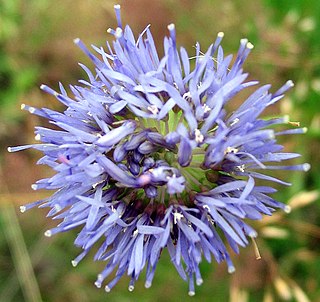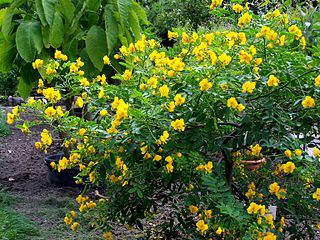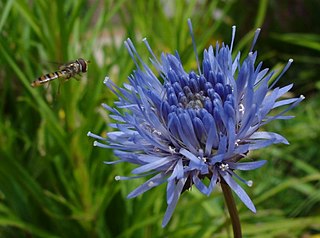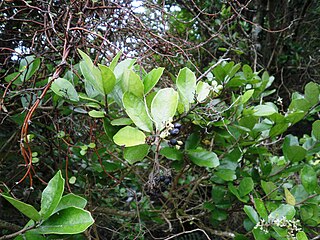
Ipomoea corymbosa is a species of morning glory, native throughout Latin America from Mexico as far south as Peru and widely naturalised elsewhere. Its common names include Christmasvine, Christmaspops, and snakeplant.

The family Campanulaceae, of the order Asterales, contains nearly 2400 species in 84 genera of herbaceous plants, shrubs, and rarely small trees, often with milky sap. Among them are several familiar garden plants belonging to the genera Campanula (bellflower), Lobelia, and Platycodon (balloonflower). Campanula rapunculus and Codonopsis lanceolata are eaten as vegetables. Lobelia inflata, L. siphilitica and L. tupa and others have been used as medicinal plants. Campanula rapunculoides may be a troublesome weed, particularly in gardens, while Legousia spp. may occur in arable fields.

Argemone corymbosa, the Mojave prickly poppy, is a flowering plant in the family Papaveraceae native to the eastern Mojave Desert of the southwestern United States. It especially common around Cima, California and the nearby community of Kelso, California. The plant grows in sandy places and on dry slopes, and is very similar to desert prickly poppy.

Jasione is a genus of flowering plants within the family Campanulaceae. It includes 14 species native to Europe, Turkey, and northwestern Africa.

Senna corymbosa is an ornamental plant in the genus Senna. It is also known as Argentine senna, Argentina senna, buttercup bush, flowering senna, Texas flowery senna or tree senna.

Jasione laevis is an ornamental plant. It was formerly known as Jasione perennis.

Jasione montana is a low-growing plant in the family Campanulaceae found in rocky places and upland regions of Europe and western Asia. Common names include sheep's-bit, blue bonnets, blue buttons, blue daisy and iron flower. Due to the similarity of the common name of "sheep's-bit" with that of devil's-bit scabious, it is sometimes called "sheep's-bit scabious" or "sheep scabious", but it is not closely related to the scabious genus (Scabiosa).

Hakea corymbosa, commonly known as the cauliflower hakea is a plant of the family Proteaceae which is endemic to the south-west of Western Australia. An attractive extremely prickly bush with sweetly scented yellowish flowers. The nectar rich blooms and dense form provides a good habitat for wildlife.
Jasione foliosa subsp. mansanetiana is a subspecies of flowering plant in the family Campanulaceae. It is endemic to central Spain. Its natural habitat is rocky areas. It is threatened by habitat loss.

Hygrophila corymbosa, commonly known as temple plant, starhorn or giant hygro, is a riparian plant in the acanthus family.
Zabelia corymbosa is a species of flowering plant in the honeysuckle family, Caprifoliaceae. It is native to Central Asia, where it occurs in Kazakhstan, Kyrgyzstan, and Tajikistan.

Keckiella corymbosa is a species of flowering shrub in the plantain family known by the common names redwood keckiella, red beardtongue, and red shrubby penstemon.

Antennaria corymbosa is a North American species of flowering plants in the family Asteraceae known by the common names flat-top pussytoes or meadow pussytoes. It is native to western Canada and the Western United States south as far as Tulare County in California and Rio Arriba County in New Mexico. It grows in moist, cool areas such as mountain meadows and riverbanks. Most of the populations are found in the Rocky Mountains, the Cascades, and the Sierra Nevada.

Chamaescilla corymbosa, commonly known as blue stars, blue squill or mudrurt, is a tuberous perennial herb species in the genus Chamaescilla. It is endemic to southern Australia.

Daviesia corymbosa, also known as narrow leaf bitter pea, is a species of flowering plant in the family Fabaceae native to the state of New South Wales in eastern Australia. A shrub to 2 m (6.6 ft) high, it grows in sandstone soils in open eucalyptus woodland or heath. It produces showy flowerheads of red and yellow flowers in the spring and early summer.

Pennantia corymbosa, commonly known as kaikomako, is a small dioecious forest tree of New Zealand.

Oldenlandia corymbosa, commonly known as flat-top mille graines or diamond flower, is a species of plant in the family Rubiaceae. It is an annual herb with ascending or erect stems which are 4-angled. Its genome size is 273.7 megabase pairs. It is a commonly used herb in China and India for treating sore eyes, anthelmintic, antirheumatic, depurative, digestive, diuretic, pectoral, fever, jaundice, child birth, and stomachic medicine, while the roots are reported to have vermifuge properties.

Lachenalia corymbosa, the corymbous Cape cowslip, is a species of flowering plant in the genus Lachenalia native to the southwest Cape Provinces of South Africa. It has gained the Royal Horticultural Society's Award of Garden Merit.
Pheidonocarpa is a genus of flowering plants belonging to the family Gesneriaceae. It includes a single species, Pheidonocarpa corymbosa, a lithophytic subshrub native to Cuba and Jamaica.

Rhynchospora corymbosa, known by the common names of golden beaksedge and matamat, is a member of the sedge family, Cyperaceae. It is a perennial herb, found globally throughout the tropics. It grows up to 2 meters tall in riverbanks, shallow pools, and swamps.
















